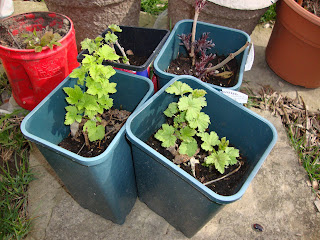 |
| Making sun brewed tea with mojito mint. Note that where some people see skids, permaculturalists see potential |
Sunday, June 24, 2012
Sun Tea, Solar Brew, Sol Highball, Photon ____ ?
Tuesday, June 19, 2012
ENTER THE MULCH
In this action-packed martial arts, permaculture, gardening thriller a small-time city farmer says “enough’s enough!” and makes the conscious design decision to take on the problems associated with water shortages and weeds brought on by climate change inconsiderate soil digging practices. After enlisting the help of a friendly local arborist who dumps 3 or 4 yards of free chipped wood mulch in his driveway, the gardening hero, along with his favourite hoe, shovel, and wheelbarrow, fearlessly covers his front beds, side beds, potato and bean patch, blueberry hedge row, hosta haven sitting area, and cherry tree dripline with a good 10-15 cm of water retaining, weed suppressing lignaceous goodness. Tension arises when he notices that there is only about half a wheelborrow full of chips left and the rose garden is still in need. Will there be enough? Watch Enter the Mulch and find out!
 |
| Will the roses get their fair share of mulch? |
Monday, June 18, 2012
Coffee Permaculture Style vs. the Typical Morning Madness
 |
| Le Café - Also a great place for a beer! |
Tuesday, March 27, 2012
Incarcerated for the unlawful containment of decaying organic matter?
Thursday, February 16, 2012
The Problem is the Solution: We Must do it for the Children!
 |
Teaching my own kids permaculture is directly aligned with permaculture's prime directive, “The only ethical decision is to take responsibility for our own existence and that of our children. Make it now". It also follows several permaculture principles in addition to the previously mentioned The Problem is the Solution. It has a Local Focus that follows the concept of “think globally, act locally”. It makes use of Onsite Resources, namely, my kids. With only two students, it starts at a Small Scale, but can be scaled upwards by teaching the lessons in the classroom and sharing the lesson plans with others. I would also like to state that it follows another permaculture principle that I have humbly coined, which is a call for action: Positive Steps Despite Pessimistic Predictions. This neologism reminds us that the race isn’t over yet and to keep going despite the odds.
In my next blog I will write about the outcomes of my first lesson with the kids. Will a third student be added? Stay tuned to find out...
 |
| My kids in the garden a few years back |
Sunday, May 22, 2011
Propagate Good Times!
Saturday, April 9, 2011
Home-style Guerrilla Gardening
My mission was to turn my side yard, which resembled a sparse, barren, steppe-like grassland, into a life-sustaining, food producing patch of goodness (see Potato Patch Pictorial below). I only had a couple of hours to perform the operation, so I had to move fast. I quickly overturned the sod in a semi-oval perimeter around the four clumps of zebra grass. I then worked inwards turning the grass over. Yes, I know, permaculturalists always preach against digging in preference to creating no-dig mulch gardens. However, I am not against doing a quick dig, as it can give both the plants and the soil forming process a head start. It is also handy to turn the grass over if you happen to be a little short of mulch, which is often the case. The next step was to empty a few bags of leaves onto the freshly turned earth. I always try to save my leaves just in case I get the hankering to make a new garden patch. I also added a little bit of peat moss to the soil. Please note that I try not to use peat moss because its use results in the destruction of wetlands. Potatoes were then placed in rows on top of the leaves and soil. Finally, I covered the whole patch with wood chips. You can get free wood chips from your handy dandy local tree cutter. They are usually more than happy to dump a load of chipped trees on your driveway or yard, as it means one less trip to the city recycling centre or wherever they have to bring it.
The whole operation only took about two hours or so. The best part was when my spouse came home and complimented me on my work. She liked the empty, Zen-like aesthetics of the grass coming up through the wood chips. The best part was when she said, “you aren't going to plant anything in it, are you?” You would think that she would know me better by now...
Potato Patch Pictorial





Check out more on guerrilla gardening at: http://www.guerrillagardening.org/




